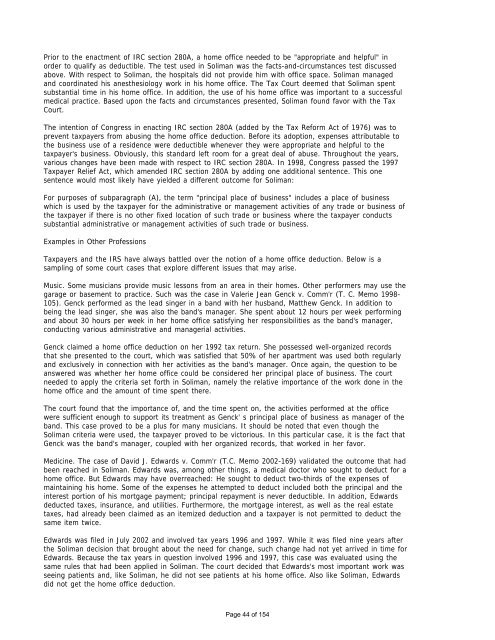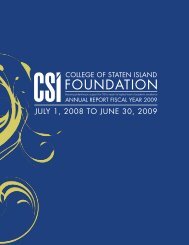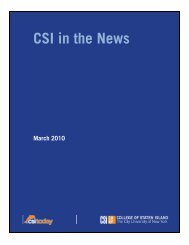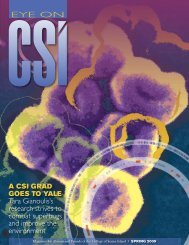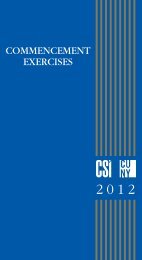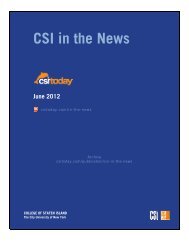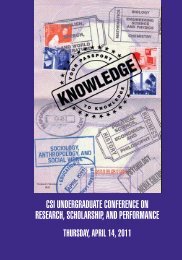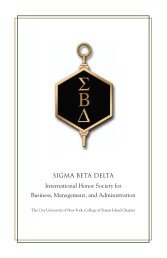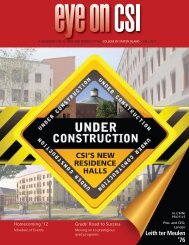Prior to <strong>the</strong> enactment of IRC section 280A, a home office needed to be "appropriate and helpful" <strong>in</strong>order to qualify as deductible. The test used <strong>in</strong> Soliman was <strong>the</strong> facts-and-circumstances test discussedabove. With respect to Soliman, <strong>the</strong> hospitals did not provide him with office space. Soliman managedand coord<strong>in</strong>ated his anes<strong>the</strong>siology work <strong>in</strong> his home office. The Tax Court deemed that Soliman spentsubstantial time <strong>in</strong> his home office. In addition, <strong>the</strong> use of his home office was important to a successfulmedical practice. Based upon <strong>the</strong> facts and circumstances presented, Soliman found favor with <strong>the</strong> TaxCourt.The <strong>in</strong>tention of Congress <strong>in</strong> enact<strong>in</strong>g IRC section 280A (added by <strong>the</strong> Tax Reform Act of 1976) was toprevent taxpayers from abus<strong>in</strong>g <strong>the</strong> home office deduction. Before its adoption, expenses attributable to<strong>the</strong> bus<strong>in</strong>ess use of a residence were deductible whenever <strong>the</strong>y were appropriate and helpful to <strong>the</strong>taxpayer's bus<strong>in</strong>ess. Obviously, this standard left room for a great deal of abuse. Throughout <strong>the</strong> years,various changes have been made with respect to IRC section 280A. In 1998, Congress passed <strong>the</strong> 1997Taxpayer Relief Act, which amended IRC section 280A by add<strong>in</strong>g one additional sentence. This onesentence would most likely have yielded a different outcome for Soliman:For purposes of subparagraph (A), <strong>the</strong> term "pr<strong>in</strong>cipal place of bus<strong>in</strong>ess" <strong>in</strong>cludes a place of bus<strong>in</strong>esswhich is used by <strong>the</strong> taxpayer for <strong>the</strong> adm<strong>in</strong>istrative or management activities of any trade or bus<strong>in</strong>ess of<strong>the</strong> taxpayer if <strong>the</strong>re is no o<strong>the</strong>r fixed location of such trade or bus<strong>in</strong>ess where <strong>the</strong> taxpayer conductssubstantial adm<strong>in</strong>istrative or management activities of such trade or bus<strong>in</strong>ess.Examples <strong>in</strong> O<strong>the</strong>r ProfessionsTaxpayers and <strong>the</strong> IRS have always battled over <strong>the</strong> notion of a home office deduction. Below is asampl<strong>in</strong>g of some court cases that explore different issues that may arise.Music. Some musicians provide music lessons from an area <strong>in</strong> <strong>the</strong>ir homes. O<strong>the</strong>r performers may use <strong>the</strong>garage or basement to practice. Such was <strong>the</strong> case <strong>in</strong> Valerie Jean Genck v. Comm'r (T. C. Memo 1998-105). Genck performed as <strong>the</strong> lead s<strong>in</strong>ger <strong>in</strong> a band with her husband, Mat<strong>the</strong>w Genck. In addition tobe<strong>in</strong>g <strong>the</strong> lead s<strong>in</strong>ger, she was also <strong>the</strong> band's manager. She spent about 12 hours per week perform<strong>in</strong>gand about 30 hours per week <strong>in</strong> her home office satisfy<strong>in</strong>g her responsibilities as <strong>the</strong> band's manager,conduct<strong>in</strong>g various adm<strong>in</strong>istrative and managerial activities.Genck claimed a home office deduction on her 1992 tax return. She possessed well-organized recordsthat she presented to <strong>the</strong> court, which was satisfied that 50% of her apartment was used both regularlyand exclusively <strong>in</strong> connection with her activities as <strong>the</strong> band's manager. Once aga<strong>in</strong>, <strong>the</strong> question to beanswered was whe<strong>the</strong>r her home office could be considered her pr<strong>in</strong>cipal place of bus<strong>in</strong>ess. The courtneeded to apply <strong>the</strong> criteria set forth <strong>in</strong> Soliman, namely <strong>the</strong> relative importance of <strong>the</strong> work done <strong>in</strong> <strong>the</strong>home office and <strong>the</strong> amount of time spent <strong>the</strong>re.The court found that <strong>the</strong> importance of, and <strong>the</strong> time spent on, <strong>the</strong> activities performed at <strong>the</strong> officewere sufficient enough to support its treatment as Genck' s pr<strong>in</strong>cipal place of bus<strong>in</strong>ess as manager of <strong>the</strong>band. This case proved to be a plus for many musicians. It should be noted that even though <strong>the</strong>Soliman criteria were used, <strong>the</strong> taxpayer proved to be victorious. In this particular case, it is <strong>the</strong> fact thatGenck was <strong>the</strong> band's manager, coupled with her organized records, that worked <strong>in</strong> her favor.Medic<strong>in</strong>e. The case of David J. Edwards v. Comm'r (T.C. Memo 2002-169) validated <strong>the</strong> outcome that hadbeen reached <strong>in</strong> Soliman. Edwards was, among o<strong>the</strong>r th<strong>in</strong>gs, a medical doctor who sought to deduct for ahome office. But Edwards may have overreached: He sought to deduct two-thirds of <strong>the</strong> expenses ofma<strong>in</strong>ta<strong>in</strong><strong>in</strong>g his home. Some of <strong>the</strong> expenses he attempted to deduct <strong>in</strong>cluded both <strong>the</strong> pr<strong>in</strong>cipal and <strong>the</strong><strong>in</strong>terest portion of his mortgage payment; pr<strong>in</strong>cipal repayment is never deductible. In addition, Edwardsdeducted taxes, <strong>in</strong>surance, and utilities. Fur<strong>the</strong>rmore, <strong>the</strong> mortgage <strong>in</strong>terest, as well as <strong>the</strong> real estatetaxes, had already been claimed as an itemized deduction and a taxpayer is not permitted to deduct <strong>the</strong>same item twice.Edwards was filed <strong>in</strong> July 2002 and <strong>in</strong>volved tax years 1996 and 1997. While it was filed n<strong>in</strong>e years after<strong>the</strong> Soliman decision that brought about <strong>the</strong> need for change, such change had not yet arrived <strong>in</strong> time forEdwards. Because <strong>the</strong> tax years <strong>in</strong> question <strong>in</strong>volved 1996 and 1997, this case was evaluated us<strong>in</strong>g <strong>the</strong>same rules that had been applied <strong>in</strong> Soliman. The court decided that Edwards's most important work wassee<strong>in</strong>g patients and, like Soliman, he did not see patients at his home office. Also like Soliman, Edwardsdid not get <strong>the</strong> home office deduction.Page 44 of 154
Real estate. John M. Rodriguez v. Comm'r (T.C. Memo 2009-22) <strong>in</strong>volved tax returns for tax years 1998-2001. Rodriguez had some success <strong>in</strong> claim<strong>in</strong>g an office <strong>in</strong> his home on <strong>the</strong>se tax returns. He was a realestate manager for several real estate developers. In addition, he handled a personal real estate bus<strong>in</strong>essthat he conducted entirely from his home. He had allocated 40% of his home as his home office becausehe stated that he used two of <strong>the</strong> five rooms for bus<strong>in</strong>ess.While <strong>the</strong> IRS agreed that <strong>the</strong> space was used regularly and exclusively for bus<strong>in</strong>ess, <strong>the</strong>y disagreed withhis percentage because <strong>the</strong> rooms were not <strong>the</strong> same size. Rodriguez was only allowed to allocate 28.5%as his home office. Although <strong>the</strong> two-prong test of Soliman was not appropriate <strong>in</strong> this case becauseRodriguez conducted his personal real estate bus<strong>in</strong>ess from only one location, his home, he still needed tobattle <strong>the</strong> issue of proper measurement. The Rodriguez case is from 2009, and is just one <strong>in</strong>dication that<strong>the</strong> office <strong>in</strong> home deduction has been <strong>in</strong> <strong>the</strong> past, is now, and will cont<strong>in</strong>ue to be an issue of debatebetween taxpayers and <strong>the</strong> IRS.Rodriguez's battle did not <strong>in</strong>volve pr<strong>in</strong>cipal place of bus<strong>in</strong>ess, which is usually <strong>the</strong> major battle; ra<strong>the</strong>r, hisfight was regard<strong>in</strong>g size. This po<strong>in</strong>t illustrates that <strong>the</strong> ability to properly claim a home office deduction,while not impossible, is difficult. Ano<strong>the</strong>r issue to keep <strong>in</strong> m<strong>in</strong>d is that while <strong>the</strong> pr<strong>in</strong>cipal place ofbus<strong>in</strong>ess is one of <strong>the</strong> stickiest po<strong>in</strong>ts to deal with <strong>in</strong> connection with <strong>the</strong> home office deduction, by nomeans is it <strong>the</strong> only one.Look<strong>in</strong>g to <strong>the</strong> FutureBoth <strong>the</strong> House and <strong>the</strong> Senate have submitted bills on <strong>the</strong> matter of home office deduction. In June2009, Congressman Charles Gonzalez (D-Tex.) <strong>in</strong>troduced <strong>the</strong> Home Office Tax Deduction Simplificationand Improvement Act; simultaneously, Senator Olympia Snowe (R-Ma<strong>in</strong>e) <strong>in</strong>troduced <strong>the</strong> bill <strong>in</strong> <strong>the</strong>Senate. The objective of <strong>the</strong> bill is to basically provide a standard deduction for a home office. Inaddition, <strong>the</strong> bill provides for a de m<strong>in</strong>imis amount of personal use when deal<strong>in</strong>g with employees ra<strong>the</strong>rthan self-employed taxpayers. While <strong>the</strong> home office would still need to be for <strong>the</strong> employer'sconvenience, it would liberalize <strong>the</strong> criteria exclusively used for bus<strong>in</strong>ess by stat<strong>in</strong>g:A portion of a dwell<strong>in</strong>g unit shall not fail to be deemed as exclusively used for bus<strong>in</strong>ess for purposes ofthis paragraph solely because a de m<strong>in</strong>imis amount of non-bus<strong>in</strong>ess activity may be carried out <strong>in</strong> suchportion.Ra<strong>the</strong>r than calculate <strong>the</strong> deduction as it is done presently, which <strong>in</strong>volves a great deal of recordkeep<strong>in</strong>gand computation, a standard rate would be used if <strong>the</strong> taxpayer chose to do so. This rate would bedeterm<strong>in</strong>ed by <strong>the</strong> Secretary of <strong>the</strong> Treasury and would be multiplied by <strong>the</strong> square footage used for <strong>the</strong>home office. A maximum amount of square footage would also be determ<strong>in</strong>ed by <strong>the</strong> Secretary.In 2009, <strong>the</strong>re had been a desire to br<strong>in</strong>g about change. Unfortunately, some legislation that gets<strong>in</strong>troduced is allowed to die, and change never comes; perhaps change will come with a newer bill<strong>in</strong>troduced <strong>in</strong> 2010. Congressman John J. Hall (DN.Y.) sponsored this bill, <strong>the</strong> Help Small Bus<strong>in</strong>esses Startand Grow Act. One provision of this bill related to a standard office deduction. It was suggested thisdeduction be <strong>the</strong> lesser of $2,500 or <strong>the</strong> gross <strong>in</strong>come derived from <strong>the</strong> <strong>in</strong>dividual's trade or bus<strong>in</strong>ess forwhich such use occurs. Once aga<strong>in</strong>, an attempt is be<strong>in</strong>g made to change <strong>the</strong> status quo, but this bill wasreferred to <strong>the</strong> Committee on Ways and Means and <strong>the</strong> Committee on Small Bus<strong>in</strong>ess, and it has not seenmovement s<strong>in</strong>ce.The concern here is whe<strong>the</strong>r <strong>the</strong>re will be a return to <strong>the</strong> abuse Congress orig<strong>in</strong>ally tried to avoid when it<strong>in</strong>itially adopted IRC section 280A. This section was adopted to prevent taxpayers from treat<strong>in</strong>g whato<strong>the</strong>rwise would be nondeductible liv<strong>in</strong>g and family expenses as bus<strong>in</strong>ess expenses.It should be noted that most of <strong>the</strong> discussion here is related to self-employed <strong>in</strong>dividuals. The criteria fora qualify<strong>in</strong>g home office deduction are a little different for those taxpayers who are employees. Theirhome office must be for <strong>the</strong> convenience of <strong>the</strong> employer; this complicates matters fur<strong>the</strong>r. Manytelecommuters today do so for <strong>the</strong> employee's own convenience. It is not uncommon, however, to f<strong>in</strong>dthat some taxpayers who work strictly from home are do<strong>in</strong>g so at <strong>the</strong> employer's request. While this maystill be appeal<strong>in</strong>g to <strong>the</strong> employee, it provides a number of benefits to <strong>the</strong> employer, <strong>in</strong>clud<strong>in</strong>g <strong>the</strong>reduction of office space and <strong>the</strong> associated high cost of commercial space.Plann<strong>in</strong>g ConsiderationsPage 45 of 154
- Page 1 and 2: CSI in the NewsOctober 2011csitoday
- Page 3 and 4: ADSPage 3 of 154
- Page 7 and 8: The sound of music aboundsSunday, O
- Page 9 and 10: serving dessert, cheese, wine and c
- Page 11 and 12: Dance teachers will walk the red ca
- Page 13 and 14: Page 13 of 154
- Page 15 and 16: "The police put out the fire and to
- Page 17 and 18: A second guesthouse owner said his
- Page 19 and 20: College of Staten Island adjunct pr
- Page 21 and 22: 10/05/2011 10:01 AMCSI Adjunct Nabb
- Page 23 and 24: Latinos, these physicians still mus
- Page 25 and 26: THURSDAY, OCTOBER 13, 2011Granitevi
- Page 27 and 28: ocks have swaths of paint on them w
- Page 29 and 30: Nurses rose to the challenge during
- Page 31 and 32: oth directly, by inducting them int
- Page 33 and 34: the value of participation in democ
- Page 35 and 36: instance of what [*585] Laurence Tr
- Page 37 and 38: spent each year covering “evoluti
- Page 39 and 40: level, would want to take a close l
- Page 41 and 42: Page 41 of 154
- Page 43: favor of Soliman. The case was appe
- Page 48 and 49: percent of them are in New Jersey.B
- Page 50 and 51: SportsPage 50 of 154
- Page 52: Lightning's Thiam Leads Strike for
- Page 55 and 56: CUNYAC/Hospital For Special Surgery
- Page 57 and 58: CUNYAC/US Army Women’s Cross Coun
- Page 59 and 60: lines, hash marks or numbers, causi
- Page 61 and 62: CUNYAC Photographer/Baruch Student
- Page 63 and 64: come back and tie the match, 8‐8.
- Page 65 and 66: CSI men lose soccer decision to St.
- Page 67 and 68: Still to maintain her hectic schedu
- Page 69 and 70: Dolphins ace FDU-Florham in 8-1 soc
- Page 71 and 72: CUNYAC/US Army Men’s Cross Countr
- Page 73 and 74: CUNYAC/US Army Women’s Cross Coun
- Page 75 and 76: CSI women lock up top spot in socce
- Page 77 and 78: Staten Island sports bulletin board
- Page 79 and 80: Morales, who became CSI president i
- Page 81 and 82: Playing at number 1 doubles, Orkis
- Page 83 and 84: Women's Swimmer Alyssa Lubrino is S
- Page 85 and 86: Rain takes toll on Staten Island sp
- Page 87 and 88: CSI women's tennis season done with
- Page 89 and 90: John Jay's Brenda Pitts Seizes CUNY
- Page 91 and 92: CSI honor roll of athletes grew to
- Page 93 and 94: Caifa, Orsi Bermudez Reyes, Stephen
- Page 95 and 96:
CUNYAC / Applebee's Men's Soccer Se
- Page 97 and 98:
StoriesPage 97 of 154
- Page 99 and 100:
Students gather at College of State
- Page 101 and 102:
—New York University—College of
- Page 103 and 104:
to the college, to create a sense o
- Page 105 and 106:
Staten Island resident part of crea
- Page 107 and 108:
Assemblyman Cusick hails youngsters
- Page 109 and 110:
College of Staten Island students r
- Page 111 and 112:
CSI gets some blow-backWednesday, O
- Page 113 and 114:
At CSI, points of light to dispel t
- Page 115 and 116:
Colleges With The Highest Acceptanc
- Page 117 and 118:
Staten Island's MTA board member Al
- Page 119 and 120:
Some no-cost solutions have been ac
- Page 121 and 122:
Staten Island branch of the JDRF.In
- Page 123 and 124:
Monday, October 24, 20112011 CUNY G
- Page 125 and 126:
Hundreds Attend Unidad Latina Confe
- Page 127 and 128:
Dr. Alvaro Carrascal, Senior Vice P
- Page 129 and 130:
what is being done at the governmen
- Page 131 and 132:
Students & AlumniPage 131 of 154
- Page 133 and 134:
Your Soap BoxWednesday, October 12,
- Page 135 and 136:
And he will almost certainly lose i
- Page 137 and 138:
She's giving young immigrants a voi
- Page 139 and 140:
AlumniPage 139 of 154
- Page 141 and 142:
Ms. Frazzetta moved with her husban
- Page 143 and 144:
Sicilian grilling.But she said one
- Page 145 and 146:
October 20, 2011Joanne S. Calcagno
- Page 147 and 148:
UFT endorses Donovan in Staten Isla
- Page 149 and 150:
“When the Lightning won the Stanl
- Page 151 and 152:
Patch Elections 2011: County Legisl
- Page 153 and 154:
fix that is shortsighted. Also, los


